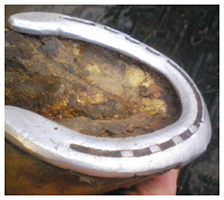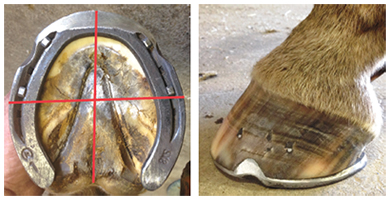Introduction
Low or under run heels affecting
the health of the foot or as a
cause of lameness are often
overlooked in the hind feet1.
Very little information has been
published on the effects of low or
damaged heels in the hind limbs.
Horses with structural damage to
the heels of the hind feet will
suffer the same consequences
associated with the hoof capsule
as noted in the front feet but the
hind feet do not appear to be
affected with the diseases of the
internal structures of the foot as
noted in the forefeet and appear
to have a better chance for
structural improvement. This
difference may be due to the
overall anatomy of the hind limbs
and the propulsionary function of
the hind feet versus the weight
bearing function of the forefeet.
Damage to the structures of the
hind feet may be well advanced
before lameness is noted. Under
run or collapsed heels in the hind
feet may lead to a subtle bilateral
lameness which is often attributed
to hock, stifle or back pain.
Often, part of the therapy for
hind limb lameness is to raise the
heels of the hind feet regardless of
the conformation of the hind foot.
Long egg bar shoes or egg bar
shoes with wedge pads are
generally used for this purpose,
however, there is absolutely no
documentation that confirms heel
elevation exerts any significant
influence on any part of the hind
limb anatomy above the distal
interphalangeal (DIP) joint2.
Furthermore, heel elevation
applied to the hind feet with
existing low heels or under run
heels will create excessive
pressure and damage the heel
structures further, leading to an
additional lameness problem.
 |
|
Figure 1. Hind feet with a low heel - A is the early stage, B is more advanced and C is severe. Note the red arrows
showing the disparity in the growth rings and the 'bull nose' forming. The black arrow denotes the end of the heel. |
 |
|
Figure 2. Figure 2A shows the position of the frog prolapsed between the branches of the shoe. Note the frog positioned below
the hoof wall when the shoe is removed (Fig 2B) and the horse standing on the frog when the foot is on the ground (Fig 2C). |
 |
|
Figure 3. Note the 'trough' present between the apex of the frog and the inner margin of the shoe. |
CLINICAL EXAMINATION OF THE FOOT
Abnormal conformation of the
hind feet is easy to recognize.
When looking at the limb from the side, the digit will show a
broken back hoof-pastern axis. The
slope of the coronary band from the
toe to the heel will have an acute
angle at the heel and the bulbs of
the heels will have a 'knob' shaped
appearance which can be seen lying
against the shoe. There will be a
disparity in the growth rings below
the coronet from the toe to the heel
and the dorsal hoof wall will
assume a "bull nosed" appearance
(Figure 1). Looking at the foot from
behind, the frog is often situated
well below the hoof wall and the
frog can be seen to prolapse down
between the two branches of the
shoe (Figure 2). The shape of the
frog is generally large from the
constant stimulation with the
ground. Upon removing the shoe,
the end of the heel of the hoof wall
is located well forward from the base
of the frog and the horn tubules will
be parallel with the ground. The
hoof wall at the heel will be thin,
there will be no angle of the sole,
and the bars may be absent. When
the foot is placed on the ground,
total weight bearing will be placed
on the frog and many horses are
reluctant to stand on the frog when
the opposing limb is lifted off the
ground. Viewing the toe area on the
ground surface of the foot, there will
be a large "trough" noted between
the apex of the frog and the inner
branch of the shoe instead of a
smooth transition of the sole from
the frog to the sole wall junction
(Figure 3). Hoof testers placed on
either side of the heel at the angle of
the sole will often elicit a painful
response and the structures will
deform.
 |
|
Figure 4. Figure 4A is moderate
low heel conformation while
figure 4B is severe. Note the
position of P2 relative to P3 on
both radiographs. This places the
load on the palmar section of the
foot. Also note the 'knob'
appearance at the heel bulb. |
RADIOGRAPHS
A lateral radiograph of the hind foot
will show a broken back hoof
pastern axis with the middle
phalanx (P2) being pushed plantar
and distally relative to the distal
phalanx (P3) during weight bearing
(Figure 4). This places excessive
stresses on the plantar section of the
joint capsule. The solar margin (plantar angle) of the distal phalanx
is lower than the dorsal margin of
the distal phalanx. The sole depth
below the dorsal margin of the
distal phalanx is markedly increased
relative to the sole depth at the heel
and the perimeter of the distal
phalanx can be seen migrating
toward the dorsal hoof wall. This is
what causes the "bull nose"
appearance of the dorsal hoof wall.
The soft tissue structures in the
plantar section are noted to be lying
against the shoe.
FARRIERY
Damage to the heels of the hind feet
is easier to improve than in the
forefeet, possibly due to the
anatomy and the difference of the
load encountered on the hind
limbs. The severity or the
distortion of the hind feet will
obviously be proportional to the
amount of time the condition has
been present and thus harder to
resolve. The first part of the farriery
is to address the frog being located
below the hoof wall. If severe, the
horse should be taken out of work
and allowed to go without hind
shoes briefly (as little as 5-7 days
may be all that is necessary). The
shoes are removed and the hoof
wall is trimmed from quarter to
quarter according to the sole depth
(Figure 5). The horse is then kept
on a firm surface, thus placing
pressure on the frog which quickly
assumes the same plane as the heels
on either side (Figure 5).
If the horse needs to continue in
work and wear shoes, the
approach can be modified. The
hind shoes are removed a day or
two before the horse is due to be
shod and the foot is trimmed as
described above. A degree pad is
cut out to fit the foot and secured
to the foot with brown gauze and
elastic tape. The horse is placed in
a stall on a firm surface for 24-48
hours.
 |
 |
|
Figure 5. Excess hoof wall is removed from toe quarter to toe quarter. This will decrease sole depth at the toe and improve the angle of the solar border of the distal phalanx with the ground.
|
Figure 6. Ground surface and side view of a hind foot shod with a Kerckhaert
SX-8 shoe. Red lines show the placement of the shoe and the dimensions of the
foot being as wide as it is long. Note the smooth transition of the sole from the
apex of the frog dorsally. Also note the breakover created in the shoe. Side view
shows the placement of the shoe and the shoe extending marginally beyond the
heels of the hoof capsule (Courtesy of Jeff Ridley, CJF). |
When the wedge pad is removed,
the frog and the hoof wall will be
on the same plane, forming a flat
even surface which includes the
frog and both heels. The horse is
then shod paying strict attention to the trim. Any additional horn at the heels can be removed so the
heels of the hoof wall are solid and approach the base of the frog,
being careful to keep the frog and both heels in the same plane. When
the hoof wall and the frog are on the same plane, the load is shared
across the plantar section of the foot. A shoe can now be fitted and
applied. We fit shoes to the hind feet the same as the front where a
line is draw across the widest part of the foot and the shoe is fitted so
the line is placed in the middle of the shoe3. In the hind feet, the
branches of the shoe may extend marginally beyond the end of the
heels (Figure 6). Breakover should be created in the hind shoe either
by forging or using a hand grinder beginning at the inner margin of
the shoe and tapering toward the periphery of the shoe. Placing
breakover in the shoe should be no different than the front feet as the
biomechanics remain the same. A recent paper in the literature
showed a smoother shift in the center of pressure and a more fluent
hoof enrollment using a rolled toe shoe on the hind feet4. In order to keep the frog and hoof wall on the same plane or if mild heel
elevation is necessary, a metal or aluminum heel plate or a leather
wedge can be placed under the shoe at the heels as long as the shoe is
fitted in the manner described above. This will concentrate the load
across the frog and heels rather than behind the heels which is the
case with a long shoe or trailers. This is usually a temporary measure
and can be discontinued once the heels have stabilized.
|
GLOSSARY OF FARRIER TERMS USED IN THIS ARTICLE
Anatomical term
Phalanx
Common name
Bone
Description
Any of the principal bones of the digit.
Anatomical term
Distal Phalanx
Common name
Coffin Bone, P3, Pedal bone
Description
Bone enclosed within hoof capsule.
Anatomical term
Distal Interphalangeal Joint (DIP)
Common name
Coffin Joint
Description
The joint between the middle(DIP) and the distal (P3) phalanx which includes the navicular bone.
Anatomical term
Plantar
Common name
Direction
Description
The caudal facing aspect of the hind limb from the tarsus (hock) distally (toward the ground).
|
CONCLUSIONS
Damage to the heels of the hind feet is much easier to resolve or
improve than in the fore feet. This could be due to the anatomy of
the hind limb along with the shape and function of the hind feet.
Once the frog has been repositioned and the heel structures have
grown, attention to the foot prep is necessary to keep the frog and
heels of the hoof wall in the same plane. The trim, along with the size
and placement of the shoe, are equally important in maintaining the
health of the heels of the hind feet.
References
- O'Grady, S.E., Poupard, D.E. Proper Physiologic Horseshoeing. Vet Clin North Am Equine Pract. 2003; 19:2:333-344.
- Bushe T, Turner TA, Poulos PW, Harwell NM: The effect of hoof angle on coffin,
pastern, and fetlock joint angle. in Proceedings of 33rd Annual Convention of Am
Assoc of Equine Practnr, 1987: 689-699.
- O'Grady, S.E. Guidelines for Trimming the Equine Foot: A Review. Proc
55thAnnu Conv Am Assoc Equine Practnr, 2009: 218-225.
- Spaak B, et al. Toe modifications in hind feet shoes optimize hoof-enrollment in
sound Warmblood horses at trot. EVJ 2013;45:485-489.

